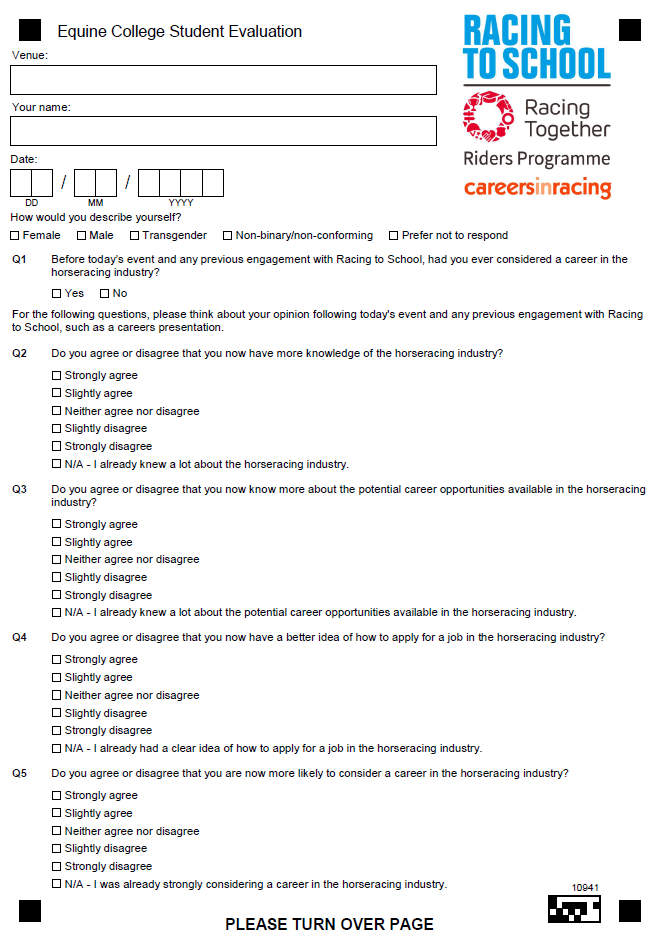Racing to School
Education charity reduce manual work by 75% by automating data collection from post event surveys with TeleForm

Background
Racing to School is an education charity that aims to inspire young minds by providing free, interactive, and healthy outdoor educational events for schools at a variety of racing venues.
The charity runs several projects and two national education programmes: one with schools and colleges and another with riders at equine colleges and pony clubs. In 2024, they supported the learning of over 17,000 young people from over 250 schools and colleges running 450 events.
Collecting post event feedback from young participants and their teachers allows Racing to School to assess their impact, adapt and improve future events, and demonstrate results to funders.
Historically, the charity used a paper-based event evaluation survey to gather feedback from around 10,000 students attending an event at one of the fifty-nine racecourses around the UK. Two Programme Managers - covering the North and South - would collate the quantitative and qualitative data and produce a quarterly report for the Board of Trustees.
Challenge
Racing to School has grown in the last five years to become racing’s largest community programme. As participation grew, a previously manageable process suddenly became almost impossible to control.
Manual data entry
Previously, the Programme Managers read the post event surveys, transcribed the data into Excel, and produced a report for the trustees. The feedback on an event is included in the report while some comments are used for fundraising initiatives and communications. This process spawned huge volumes of manual work - much of it repetitive and error-prone.
“It was a very painstaking and slow process,” explains Ollie McPhail, Programme Manager. "We knew that there was probably a better way of capturing the data.” McPhail says.
Time-consuming
The Programme Managers spent at least eight days each quarter collating the data and preparing the board report.
As Ollie recalls "The fixture list was released late last year which meant our planning cycle was delayed and it got to a point where we physically did not have the time to process the evaluation forms manually".
Less productivity
On top of that, the manual process was labour-intensive with Ollie and his colleague taken away from high-value tasks to focus solely on collating the data and creating the report. As a result, it would cost the charity to provide cover at events while Ollie and his colleague remain in the office.
Solution
In 2024, the charity secured funding from the Racing Foundation to support the organisations development across several areas including a digital capture system.
"We did consider an online survey solution to gather the data," recalls Ollie. "However, we soon realised it was not feasible to gather the data digitally because our events are held at racecourses. At the same time, it’s not straightforward to ask the school or college for event feedback once students have returned to their normal learning environment because they do not always attend the same school or college”.
Looking for a solution, Ollie soon realised he could digitalise event feedback once captured and that's when the charity came across ePC.
"At that point, I didn't know if it was viable, so I was concerned about wasting my time. I had a conversation with ePC to explain our requirements and was pleasantly surprised to hear it could work and what was possible."
The next step was to attend an in-person demonstration.
"We provided ePC with our post event feedback forms ahead of the demo,” says Ollie. "I was extremely impressed that they recreated our forms ahead of our meeting, so I got a real feel for how the system would work.”
To solve their challenges, ePC developed an innovative solution, leveraging OpenText TeleForm, to intelligently capture and validate data on event evaluation forms, removing the need for manual processing.
Better form design
One of the first challenges was to redesign the post event evaluation templates in TeleForm for accurate recognition. These included:
- Teacher evaluation
- Equine college student evaluation
- Pupil evaluation
- Pony Club member evaluation
- Parent/Instructor evaluation
"The form design was quick,” says Ollie. "A lot of the legwork had been completed during the pre-sales stage, but it also helped the survey questions were unlikely to change substantially, so I didn’t need significant handholding or training.”

Eliminate manual work
After an event, the forms are filled in by pupils, returned to the office, and scanned into TeleForm through a connected scanner.
I’m just amazed at how quickly it works and how efficient it is. You put the feedback forms in the scanner, and it eats them up. It takes 20 seconds to scan 50 forms which would have taken me an hour and a half to read and transcribe. I often find myself thinking that’s another hour saved
Ollie McPhail, Programme Manager, Racing to School
Save time
Before TeleForm, Racing to School would need to schedule 3-4 hours to collate feedback from each event manually. Today, Ollie can quickly scan post event surveys while working on other tasks with the process taking less than ten minutes. This has saved the charity around 30 days a year, releasing Ollie to deliver more of the programme while his colleague’s sole focus is now on event planning and delivery.
"There are days when we both work at the same event so I will get handed a pile of event evaluation forms to scan,” says Ollie. My colleague will not need to give it a second thought. It's taken that part of her role away.”
I wish I'd found TeleForm ten years ago. I could have saved so much time over the last few years
Ollie McPhail, Programme Manager, Racing to School
Increased productivity
One of the main benefits has been releasing one employee, or approximately 1,879 hours, to deliver programmes and plan events.
"We’re a small but growing charity, and process efficiencies like the ones facilitated by ePC means that we can deliver more events with the same resources,” says Ollie.
Once scanned, TeleForm reads checkbox (OMR) and handwritten (ICR) fields and extracts the information. If TeleForm is uncertain about a character, it is highlighted for review.
“The forms are filled in by children,” says Ollie. “Occasionally I need to manually review a form where a child has put four crosses and one tick, but I get very few exceptions, and when I do, I find the process quick and easy.”
The final stage sees data exported to an Excel spreadsheet and comments extracted as images for Ollie to review for inclusion in the board report.
Implementing TeleForm was “pretty straightforward,” according to McPhail. He reveals “ePC came to the office to set up the system on my laptop and did a quick walk-through, and away we went. The team was also quick to support us in the first few weeks when we had a couple of teething problems. They have been brilliant, and I cannot praise them highly enough.”
Results
TeleForm has been instrumental in eliminating large volumes of repetitive work and freeing up resources.
"Overall, TeleForm has significantly reduced manual work, and it now takes 75% less time to analyse post event surveys”, says Ollie.
Now in place for ¾ of a year, TeleForm has reduced the time to collate feedback after an event from eight days to less than half a day per quarter. This has allowed the two Programme Managers to deliver around thirty extra events in the first year and freed up 1,879 hours. The annual saving means the system will pay for itself in under 18 months.
"TeleForm has 100% been a worthwhile investment”, concludes Ollie.
I wish I'd looked into it ten years ago! It was a big expense for a small charity, but it will save us money within 18 months. It's something that's been a great benefit to us and I would highly recommend it to any organisation.
Ollie McPhail, Programme Manager, Racing to School
